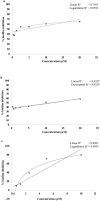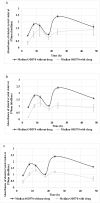Antibiofilm agents with therapeutic potential against enteroaggregative Escherichia coli
- PMID: 36201560
- PMCID: PMC9578610
- DOI: 10.1371/journal.pntd.0010809
Antibiofilm agents with therapeutic potential against enteroaggregative Escherichia coli
Abstract
Background: Enteroaggregative Escherichia coli (EAEC) is a predominant but neglected enteric pathogen implicated in infantile diarrhoea and nutrient malabsorption. There are no non-antibiotic approaches to dealing with persistent infection by these exceptional colonizers, which form copious biofilms. We screened the Medicines for Malaria Venture Pathogen Box for chemical entities that inhibit EAEC biofilm formation.
Methodology: We used EAEC strains, 042 and MND005E in a medium-throughput crystal violet-based antibiofilm screen. Hits were confirmed in concentration-dependence, growth kinetic and time course assays and activity spectra were determined against a panel of 25 other EAEC strains. Antibiofilm activity against isogenic EAEC mutants, molecular docking simulations and comparative genomic analysis were used to identify the mechanism of action of one hit.
Principal findings: In all, five compounds (1.25%) reproducibly inhibited biofilm accumulation by at least one strain by 30-85% while inhibiting growth by under 10%. Hits exhibited potent antibiofilm activity at concentrations at least 10-fold lower than those reported for nitazoxanide, the only known EAEC biofilm inhibitor. Reflective of known EAEC heterogeneity, only one hit was active against both screen isolates, but three hits showed broad antibiofilm activity against a larger panel of strains. Mechanism of action studies point to the EAEC anti-aggregation protein (Aap), dispersin, as the target of compound MMV687800.
Conclusions: This study identified five compounds, not previously described as anti-adhesins or Gram-negative antibacterials, with significant EAEC antibiofilm activity. Molecule, MMV687800 targets the EAEC Aap. In vitro small-molecule inhibition of EAEC colonization opens a way to new therapeutic approaches against EAEC infection.
Conflict of interest statement
The authors have declared that no competing interests exist.
Figures










Similar articles
-
Association of putative enteroaggregative Escherichia coli virulence genes and biofilm production in isolates from travelers to developing countries.J Clin Microbiol. 2007 Jan;45(1):121-6. doi: 10.1128/JCM.01128-06. Epub 2006 Nov 8. J Clin Microbiol. 2007. PMID: 17093030 Free PMC article.
-
Aggregative Adherence and Intestinal Colonization by Enteroaggregative Escherichia coli Are Produced by Interactions among Multiple Surface Factors.mSphere. 2018 Mar 21;3(2):e00078-18. doi: 10.1128/mSphere.00078-18. eCollection 2018 Mar-Apr. mSphere. 2018. PMID: 29577084 Free PMC article.
-
Remarkable antibiofilm activity of ciprofloxacin, cefoxitin, and tobramycin, by themselves or in combination, against enteroaggregative Escherichia coli in vitro.Diagn Microbiol Infect Dis. 2023 Nov;107(3):116048. doi: 10.1016/j.diagmicrobio.2023.116048. Epub 2023 Aug 2. Diagn Microbiol Infect Dis. 2023. PMID: 37657231
-
A review of an emerging enteric pathogen: enteroaggregative Escherichia coli.J Med Microbiol. 2006 Oct;55(Pt 10):1303-1311. doi: 10.1099/jmm.0.46674-0. J Med Microbiol. 2006. PMID: 17005776 Review.
-
Autotransporters and virulence of enteroaggregative E. coli.Gut Microbes. 2011 Jan-Feb;2(1):13-24. doi: 10.4161/gmic.2.1.14933. Gut Microbes. 2011. PMID: 21637014 Review.
Cited by
-
Pentamidine inhibition of streptopain attenuates Streptococcus pyogenes virulence.Microbiol Spectr. 2025 Aug 5;13(8):e0075825. doi: 10.1128/spectrum.00758-25. Epub 2025 Jun 23. Microbiol Spectr. 2025. PMID: 40548752 Free PMC article.
-
Pentamidine inhibition of streptopain attenuates Streptococcus pyogenes virulence.bioRxiv [Preprint]. 2025 Mar 12:2025.03.12.642885. doi: 10.1101/2025.03.12.642885. bioRxiv. 2025. Update in: Microbiol Spectr. 2025 Aug 5;13(8):e0075825. doi: 10.1128/spectrum.00758-25. PMID: 40161583 Free PMC article. Updated. Preprint.
References
-
- Liu L, Johnson HL, Cousens S, Perin J, Scott S, Lawn JE, Rudan I, Campbell H, Cibulskis R, Li M, Mathers C, Black RE; Child Health Epidemiology Reference Group of WHO and UNICEF. Global, regional, and national causes of child mortality: an updated systematic analysis for 2010 with time trends since 2000. Lancet 2012; 379(9832):2151–61. doi: 10.1016/S0140-6736(12)60560-1 . - DOI - PubMed
-
- UNICEF 2019. Diarrheoa data: Diarrheoa as cause of death in children under 5. https://data.unicef.org/resources/dataset/diarrhoea/. Accessed 5th October, 2019.
-
- Institute for Health Metrics and Evaluation (IHME) Global burden of disease, 2018. Annual deaths from diarrheal diseases differentiated by age categories. Retrieved from https://ourworldindata.org/diarrheal-diseases on 29th January, 2020.
-
- Acosta AM, De Burga RR, Chavez CB, Flores JT, Olortegui MP, Pinedo SR et al.. Relationship between growth and illness, enteropathogens and dietary intakes in the first 2 years of life: findings from the MAL-ED birth cohort study. BMJ Glob Health 2017; 2(4):e000370. doi: 10.1136/bmjgh-2017-000370 . - DOI - PMC - PubMed
Publication types
MeSH terms
Substances
Grants and funding
LinkOut - more resources
Full Text Sources
Medical
Miscellaneous

